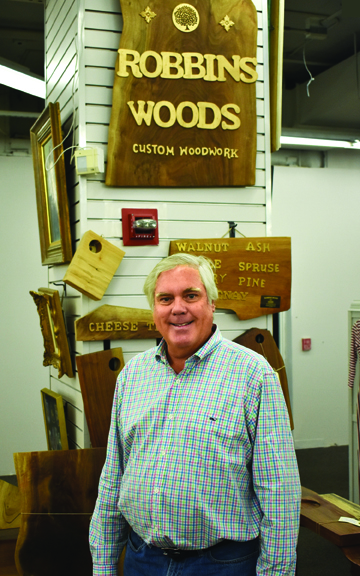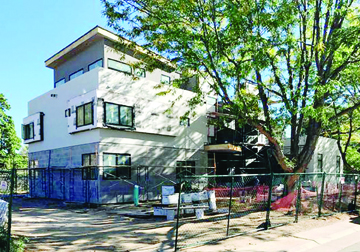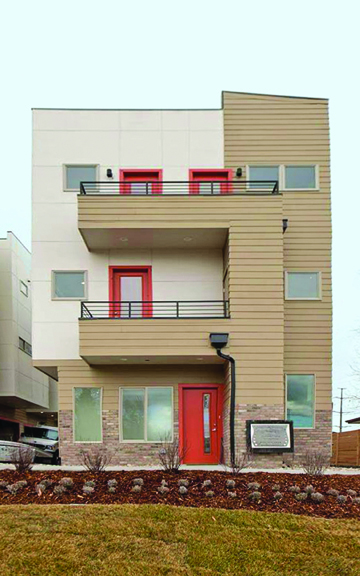
by Mark Smiley | Oct 2, 2018 | Main Articles
The Extraordinary Journey Of Richard Robbins
by Charles C. Bonniwell

Watch Expert: Peter James, the worldwide mystery novelist, has utilized Richard Robbins’ expertise on early pocket watches in his book Dead Man’s Time and he recognized him by name as an “expert in timepieces in Denver, Colorado.”
Richard Robbins had lived what it looked like a perfect corporate executive life. After graduating from college he joined Kraft Foods, a Fortune 500 company. He traveled around the country doing important assignments as a key executive for over 20 years. He decided the constant moving was too stressful for his wife and two daughters, so he took a job as the president and CEO of a local bank in the Chicago area.
But after a decade as a bank president, Robbins went through a devastating divorce and he questioned whether he wanted to spend the rest of his productive working life in the role of a button down corporate executive. After a brief stint in New Zealand, he decided to move to the wilds of Colorado, i.e. Cherry Creek.
One of the verities of living a happy life is to find something you love and figure out a way to make money doing it. Robbins’ father had been a highly successful antique furniture dealer and Robbins had retained a love of beautifully made furniture. He

Handmade: Robbins has a passion for crafting walnut furniture and collecting and repairing early pocket watches from the 1700-1800 ca. His businesses can be found on the second floor of The District Shops, formerly occupied by Bed Bath & Beyond at 2500 E. First Ave in Cherry Creek North.
decided to start making desks and tables from the trunks of whole trees. The pieces of furniture can weigh as much as 100 pounds and are built to last generations.
He took space out at The District Shops in Cherry Creek Shopping Center which provides areas for artisans and other small businesses in the old Bed Bath and Beyond store. He crafts the fine furniture in the basement area of the shopping center at Robbins Woods.
In addition to his love of furniture, Robbins had a love for antique pocket watches. While in the Chicago area he had learned the ins and outs of pocket watches from a third generation Middle Eastern pocket watchmaker over a four-year period.
He decided to also turn that knowledge into a business venture. He acquired a large inventory of antique pocket watches from sales across the country and founded The Pocket Watch Shop leasing out separate space in The District. He repairs, buys, sells and trades the very best in antique pocket watches, specializing i

Many Talents: Richard Robbins has an unusual background which began with Kraft General Foods (20 years), followed by bank president in Chicago for 10 years. He now crafts all sorts of items out of different types of woods, including walnut and oak.
n timepieces made in America, England, France and Switzerland.
Robbins makes sure the timepieces are in perfect working order and meticulously researches, in the extensive timepiece library he has collected, the country of origin of each watch and the individual craftsman whose skill and inventive daring resulted in the pocket watch. When you acquires a pocket watch from The Pocket Watch Shop you are acquiring not only a timepiece, but a piece of history which has been carefully documented.
His expertise has become so well known that best-selling novelist Peter James extensively consulted him for his horological knowledge for his best seller Dead Man’s Time which has sold over 13 million copies. James repeatedly acknowledged and thanked Robbins for his help in the introduction to the novel.
Now a full-time Cherry Creek artisan, Robbins lives in a home in Washington Park along with his second wife and soul mate Kerry Moriarity who works as a custom travel agent in Cherry Creek. He stays closely involved with his two daughters, both of whom are graduates from the University of Colorado-Boulder, with one living in Denver and the other in the Chicago area.
To reach Richard Robbins call 847-370-0825, or visit www.antiquepocketwatchbuys.com.

by Mark Smiley | Oct 2, 2018 | Glendale City News
Army Takes Top Military Honors, British Army Secures Overall Tournament Victory
by John Arthur
Writer for and on behalf of the City of Glendale

Glendale’s annual RugbyTown Sevens Tournament took place the last weekend of August, and alongside the Bruises and Brews Beer Festival, the event not only drew national and international fans, but for the seventh year running once again proved that Infinity Park is the beating heart of American rugby. Twenty domestic and international rugby teams competed in more than 60 matches over the weekend, each vying for the $10,000 winner take all championship purse. Representative teams from all five branches of the U.S. Military, as well as the British Army and Royal Armoured Corps, competed alongside participating teams from the United States, Canada, Europe, and the Caribbean.
Reaching fans in nearly 60 countries across the globe, this year’s tournament saw a 22% increase in new viewers, as well as a nearly 25% increase in viewer hours — rugby’s meteoric growth in the United States, fueled by events like RugbyTown 7s, shows no signs of slowing. The tournament has historically invited and featured new teams and talent, and 2018 was no exception. Showcasing both new faces and seasoned veterans, the history and world-class facilities at Infinity Park have and will continue to draw teams from far and wide. The Bruises and Brews Beer Festival, which was held over two days for the first time in 2018, celebrates local Colorado brewers and consistently demonstrates the age-old adage: beer and rugby — better together.
Pool play kicked off at 11 a.m. on Friday August 24 and continued well into the evening. In addition to the ultimate winner-take-all tournament purse, U.S. Military teams competed to set the stage for separate Military Championship honors on Sunday. The U.S. Army team ultimately defended their multi-year champion status, having won every year since 2013. The action was hot, humid, and fast-paced. Conditions improved to some extent over the course of the weekend’s play, but every team had to contend with the shining Colorado sun and playing at elevation — a factor that proved difficult for many visiting squads. Competition was noticeably more closely matched on the second day of pool play, with visiting teams likely becomin

GLENDALE, CO – AUGUST 26: U.S. Army vs Denver Rugby 7s Selects during RugbyTown7s at Infinity Park on August 26, 2018 in Glendale, Colorado. (Photo by Seth McConnell)
g more accustomed to fast-paced sevens rugby action at a mile above sea level. Sunday saw the conclusion of the RugbyTown 7s at Infinity Park, the final day of the seventh annual tournament reaching its exciting crescendo.
This year’s tournament was characterized not just by the exceptional play from the domestic and international teams, the cheering fans, and the party atmosphere of the two-day Bruises and Brews Beer Festival, but also by the Colorado weather. High temperatures, unseasonable humidity, and smoky conditions from wildfires in the western U.S. made the fast-paced play even more difficult — not to mention thunderstorms threatening game stoppages. Teams coming from overseas or from lower elevations clearly struggled to acclimate to Glendale’s mile-high elevation and the accompanying reduction in oxygen: the setting of this year’s tournament helped separate winners from losers.
Sunday Wrap Up — Tournament Results
Shield Final — Sacramento Eagles Win Shield Over Washington Athletic Club
The Colorado weather once again proved a factor in the final day of the 2018 RugbyTown 7s Tournament, multiple lightning delays postponing the competition for the RT7s Shield. In spite of the possibility of storms, conditions were cooler to begin the contest, though strong breezes complicated conversion kick attempts. The Sacramento Eagles piled on an early offensive burst that Washington Athletic Club was ultimately unable to match. The Seattle team rallied in the second half of play, but the California side took home the shield with a 24-12 victory.
Paula Buitu of the Eagles had nothing but compliments for the team’s first-time tournament experience: “It was fantastic and well organized. We were proud to participate, especially as a first-year team. We came in battling from the first day, and it’s a great moment for us to be Shield Champions. It’s one we won’t forget.”
Bowl Final —

GLENDALE, CO – AUGUST 26: Washington Athletic Club vs Sacramento Eagles during RugbyTown7s at Infinity Park on August 26, 2018 in Glendale, Colorado. (Photo by Seth McConnell)
Misfits Best Griffins In Bowl Final
The Dark n’ Stormy Misfits took down the Southern California Griffins in a tightly contested match that went to the wire. SoCal made a late effort to overcome the Misfits but were unable to claim the win. The RT7s Bowl will remain in Colorado with a deserving first-year Misfits team.
Plate Final —
U.S. Army Takes Down Denver 7s Selects, Secure RT7s Plate Victory
The U.S. Army battled the local Denver 7s Selects in a close fought and entertaining match for the tournament Plate Title. Army proved too strong for the mile high side, securing a 26-17 win to take the Plate, and adding to an already impressive tournament showing that included a sixth-consecutive U.S. Armed Forces Championship.
Mark Drown, of the U.S. Army 7s side, had high praise for the tournament: “Without question, Rugbytown 7s is the Premier rugby sevens event in North America. The facilities, organization, live stream, and color commentary are all world class,” he said. “The Army’s experience at Glendale has been exceptional. Capturing the Plate was a great culmination for us after a long tournament. We look forward to defending our six consecutive [Armed Forces] championships in the years to come.”
U.S. Army Sergeants Dacoda Worth and Michael Melendez-Rivera, who both play on the Army 7s team, were equally happy with the squad’s tournament experience: “We all know to take nothing for granted,” said Worth. “We all play for each other, and off the pitch we continue to have amazing relationships even though we are all in various locations.” Melendez-Rivera added that RugbyTown is an event the team looks forward to year after year: “It’s an amazing facility with amazing fans. We’re blessed to be able to defend our title and represent our nation. Team member Captain Aaron Retter sums the experience: “Earning our sixth title and the Plate Championship feels absolutely incredible. We play not only for the name on the front of our jersey, but for the flag.”
Third Place —
Collegiate All-Americans Take Third Place Overall In 2018 RugbyTown 7s
Hot on the heels of the contest for the Plate, the Collegiate All-Americans met the Ramblin’ Jesters for the honor of third place in this year’s tournament. With tremendous showings from both teams throughout the weekend, the match was highly anticipated and a crowd favorite as Sunday play wound down. A tight fight saw the young Americans take the third place spot in the 2018 RT7s tournament with a 24-14 win. Breakout stars in this year’s competition, the all Americans overcame the crowd favorite Ramblin’ Jesters to take third place overall.
All-Americans Head Coach Steve Lewis was as impressed as anyone in the stands with his team’s performance: “We made great progress: a great performance by young American players in a field littered with professionals,” he said. “Once again it was a terrific experience for the Collegiate All-Americans and we are grateful indeed to everyone at the City of Glendale for making it possible.”

GLENDALE, CO – AUGUST 26: Collegiate All Americans vs Ramblin Jesters during RugbyTown7s at Infinity Park on August 26, 2018 in Glendale, Colorado. (Photo by Seth McConnell)
Cup Final —
British Army Secures First RugbyTown 7s Cup Victory, Take Home $10,000 Purse – Favored Tiger Rugby Finish Weekend As Runners Up In Hard-Fought Three Days Of Sevens Play
British Army met Tiger Rugby on the Infinity Park pitch on the evening of Sunday August 26 to decide who would earn the 2018 RT7s Championship in the weekend’s final game. Evenly matched, the two squads played a physical first half. Vying for the tournament’s winner-take-all, $10,000 purse, Tiger went into the break with a 5-0 lead over British Army.
Coming off the half-time rest, the hard-hitting action continued. The British Army side dotted down early and converted to give their team a 7-5 lead, but the tough play wasn’t over. In a defensive second-half shootout, the British Army proved their mettle, securing a tight but definitive 7-5 victory. The U.K. team took home not just the five-digit prize purse, but top honors as Cup winners and the overall 2018 RugbyTown 7s Champions.
RugbyTown 7s epitomizes Glendale’s eponymous title: RugbyTown USA. In 2018, the tournament drew talent from near and far, attracting U.S. military teams, college athletes, and rugby players and fans from across the globe. Embracing Colorado’s seemingly insatiable thirst for craft beer, festivities also included the two-day Bruises and Brews Beer Festival.
As in years past, the competition was fierce, the crowds large and fanatic, and the growth of rugby as a mainstream sport in the United States palpable. Champions were crowned, cold mugs downed, and history once again written for rugby sevens in America.

by Mark Smiley | Oct 2, 2018 | Main Articles
Permits For New Homes Are At A 13-Year Peak; Buyers Value Square Footage Over The Sticker Price
by Glen Richardson

Bold Building Blocks: Builders in the Hilltop neighborhood are finding constant inspiration in replacing spacious old homes with bigger, brash designs.
Despite years of pushback by residents and multiple city ordinances that can delay the process, the scrape and construction of supersized single-family homes in Denver can reasonably be described as a building frenzy. Endlessly larger homes are replacing older homes and tidy rows of bungalows in virtually every Denver neighborhood.

Hilltop Status Symbol: Grand old Hilltop homes are being replaced with new builds such as this house on Fairfax St. designed by architect Collin Griffith and built this year by Forte Distinctive Homes.
Hitting levels that haven’t been seen in years, they are a source of controversy for their impact on gentrification and historic preservation. Furthermore many longtime residents say supersized homes are destroying the character of streetscapes while not respecting the context of the neighborhood. They also complain that as developers maximize the square footage of gigantic homes they not only sacrifice lawn and backyard size but also the views from nearby occupied houses.
Whatever you call it, the process is that developers or individuals find small older houses on large lots, scrape them away, build supersized homes on spec, and then sell them for unholy amounts of money. It’s a business. It’s a neighborhood. It’s a business and a neighborhood. In Wash Park, for example, at 600 S. Franklin St., Forte Distinctive Homes scraped a 1920s triplex and constructed a contemporary three-story home overlooking Washington Park Lake. The 4,800-sq.-ft. four-bedroom home on a corner lot sold in August for $3.66 million.
Permit Predicament

New Look Homes: Sustainable Design Build shows off streets of tall and slim townhomes such as this on streets off of West Colfax Ave.
Permits to build single-family homes are the highest they have been in 13 years. Community Planning & Development issued more than 35,000 permits in the first half of 2018, up roughly 2.1% from last year’s record-breaking frenzy. Realtors say there are currently about 500 new home construction and housing projects underway in Denver. That includes nearly 30 new home and townhome developments in Cherry Creek.
For buyers wanting to purchase a property with the house intact the wait time is often a dilemma. They are being told if they plan to scrape the home to build new, the delay time for a permit could be up to three months due to all the construction activity in the city.
The number of home scrapes completed in the last three years is pushing into new territory. Drive down what are previously untouched streets in a good number of neighborhoods today and you’ll see developers working on new projects that were bypassed for decades.
Changing Colfax
On West 13th St. a block south of West Colfax Ave., every street for 10 blocks has had at least one lot scraped and developed in the last three years. That puts the West Colfax neighborhood — where rows of townhomes are replacing 100-year-old bungalows — at or near the top for scrapes competing with hot spots in Wash Park and Hilltop.
Almost no part of town has had the block-by-block density of scrapes as West Colfax. As many as 1,200 structures have been demolished and replaced with new homes since 2016. Sustainable Design Build’s Mike McCarty has worked on five residential projects on three streets. He has built 34 new townhomes, averaging 1,200-sq.-ft. and priced between $400,000 and $500,000.

Scrape Off Sequel: Forte Distinctive Homes scraped a Wash Park 1920s triplex and replaced it with this four-bedroom home that sold in August for $3.66 million.
In 2015 he was buying lots with bungalows built between 1920 and 1940, paying $300,000 and $750,000, depending on the lot size. He puts four townhomes on the $300,000 lot and eight homes on those costing $750,000. In the last three years, however, he says the cost for land has risen from $50,000 to $100,000 per finished townhome unit.
Spacious Styles Scraped
Builders in historic Hilltop are scraping away already spacious homes in 22 different architectural styles — grand old homes in an assortment of Tudor, English, Mediterranean Revival, Georgian, Regency and Mid-Century Modern — and replacing them with gigantic newly built “status-symbol” classics.
The area is a one square-mile neighborhood bordered by Colorado Blvd. and Holly St., from 6th Ave. to Alameda. The eastern boundary is irregular, extending to Quebec St. at the north end, and encompassing properties on both sides of Monaco Pkwy. at the south end.
Combining indoor and outdoor space is the trend in these colossal new Hilltop houses that often start at $2.5 million or more. Architects and builders frequently scrape the house being demolished to the foundation, leaving  the base intact. That reduces the time to get permits and cuts the cost of installing new water and gas taps.
the base intact. That reduces the time to get permits and cuts the cost of installing new water and gas taps.
Pilfering Park Porches
With tree-lined streets and a 161-acre park and recreational area, Washington Park is one of the Denver’s favorite “hoods.” In the last couple of years, however, countless brick homes with quaint front porches have been scraped away for new builds that are popular and pricey.
The comfortable blend of historic homes adorned with pretty gardens, plants and landscaping, are constantly being replaced by radically bigger homes in more contemporary styles. Sprawling structures, moreover, are replacing lawns and landscaping in sizeable chunks at a good number of new build sites.
The trend is even more noticeable in East Wash Park as scraped lots are chock-a-block packed with big single-family houses. In fact the East Wash Park area now ranks third for the number of scrapes, trailing only upstarts Sloan’s Lake and Berkeley.
Scrape-Offs Stamina?

Rows Of Townhomes: Rows of under construction townhomes such as this are replacing 100-year-old bungalows on streets south of West Colfax.
Some homeowners see scrape and build as revitalizing old neighborhoods. Others, however, see it as people being pushed out and the historic nature of neighborhoods being destroyed, which does often happen. For others, scrape-offs can be an artistic and visual concern. Some contemporary architectural styles appear boxy and flaunt bold colors that aren’t attractive to everyone in a neighborhood.
For developers, however, scrape-offs are a business bonus created by an aging housing stockpile that is a lot smaller than the current consumer demands. Builders also argue that older homes are not suitable for today’s lifestyles or energy requirements.
Asking prices for supersized houses will likely continue to ascend, and this alone could eventually price builders out of a market they helped create. Much like cattle that have over-grazed a pasture, they will be forced to move on to even greener neighborhoods.

by Mark Smiley | Oct 2, 2018 | General Featured
Well-Established Retirement Community Brings Contemporary New Look To Southeast Denver
by Julie Hayden

Best Meals In Town: The Dining Room at Springbrooke Retirement Community has a brand new decor but the same great dining experience Springbrooke is known for.
Springbrooke Retirement Community, southeast Denver’s well-established retirement community, that’s who!
The multi-million-dollar renovation speaks volumes, as the community’s local owners, Michael Opatowski and Stephen Elken, believe their residents deserve the very best. In addition to quality health care, restaurant style dining, a full calendar of activities and a magnitude of other amenities that their residents enjoy, they know that re-investing in their building is very important. “We’re always striving to be the leader in the senior housing industry, and when I’m in Springbrooke weekly and talk with our residents and hear how happy they are then I know we have done our job,” says owner Michael Opatowski.
Springbrooke Retirement Community is conveniently located in central Denver near Leetsdale and Monaco.
The 142-unit community offers a lifestyle for everyone, including In

Multi-Million Dollar Renovation: Residents and family members at Springbrooke Retirement Community give rave reviews to the all-new look in the main Living Area.
dependent Living, Assisted Living and the newly remodeled Memory Care unit. Springbrooke also offers outpatient Occupational Therapy, Speech Therapy and Physical Therapy onsite.
Residents rave the “facelift” is gorgeous. Each apartment boasts brand new cabinets and lighting and features new granite counter tops and carpet. You notice the new décor as soon as you walk in the door, as the Entry, Living Room and Bistro are also newly remodeled. The Library, Dining Rooms, Fitness Center and Serene Courtyard also have a wonderful new look.
One thing that hasn’t changed is the excellent dining experience. Opatowski and Elken have owned Springbrooke Retirement Community for almost 10 years and their amazing chef, along with other upper level management and staff members have been part of the Springbrooke community from the beginning.

Relaxing And Restful Serene Courtyard: In addition to spectacular mountain views from apartment balconies, Springbrooke Retirement Community offers a beautiful courtyard for all to enjoy.
The delicious meals are just one thing that sets Springbrooke Retirement Community apart.
Residents and family members truly appreciate that Springbrooke is locally owned and operated. The building offers spectacular mountain views and there are balconies off every apartment.
Opatowski adds, “Longevity of our staff is also an anomaly and differentiates us. Our Executive Director, LPN, Activities Director and Culinary Chef have been with us since we opened the doors 10 years ago.”
The owners invite all to stop by Springbrooke Retirement Community. “Sit in on a lecture, have a cup of coffee in our Bistro, enjoy a lunch and spend a quiet moment in our Serene Courtyard. We’re proud of our ‘facelift’ and happy to show it off.”

by Mark Smiley | Oct 2, 2018 | Travel

Pizza Truck: Allegra’s Pizza now operates out of their pizza truck at Odyssey School of Denver at 21st and Monaco and Long Table Brewhouse at 29th and Fairfax. Pickup orders can be placed by calling 303-333-4442 or online at allegraspizza.com.
by Mark Smiley
For the last 10 years, residents of Park Hill and outlying neighborhoods enjoyed ordering pizzas from Allegra’s Pizza which was situated within Oneida Park at 23rd and Oneida in Park Hill. Rick Firmine and Todd Snyder, the current landlords purchased the strip in January 2017 and have been planning new development ever since.
The new development includes a 7,000 square foot outdoor courtyard for kids to play and adults to hang out. Included in this new development will be Little Man Ice Cream and a second location for the popular Virginia Vale restaurant Esters Neighborhood Pub. Paul Sullivan, owner of Esters, indicates that after taking possession this July of the 5,000 square foot property, the former home of a liquor and convenience store, he hopes to open by the end of the year.
When Allegra’s Pizza’s lease was up in April 2018, Firmine and Snyder wanted them to move across the street. Tony Uva, owner of Allegra’s Pizza, wanted to stay in Oneida Park but rather than moving across the street which Uva says was an expensive proposition, Uva suggested taking the vacant store next door to the pizzeria and creating a bistro.
That didn’t fit with the plans so Uva decided to take his show on the road, literally. Allegra’s Pizza closed its doors in Oneida Park on March 30, 2018, and reopened on May 18, 2018, operating out of the pizza truck they have owned the last couple of years. “Essentially what it is, is a kitchen on wheels,” said Uva. They have a permanent location in the parking lot of Odyssey School of Denver at 21st and Monaco where Uva was once a reading volunteer.
“We looked at other locations along Colfax and elsewhere and rent for 1,200 square foot of space was going for $5,000 a month,” said Uva. “We are paying the Denver Public Schools $25 per hour.”

New Plans: Oneida Park, former home of Allegra’s Pizza, is preparing for major renovations including a 7,000 square foot park set to open in 2018.
Tony and his wife Christine remain optimistic that the existing customer base will remain. The truck has the capacity to bake twelve 16” pizzas at any given time, and their two employees (down from 11) will keep the pies baking. Allegra’s Neapolitan Pizza operates the truck on Thursdays at Long Table Brewhouse at 2895 Fairfax Street in Park Hill and Fridays at Odyssey School. They open at 5 p.m. on both nights and at both locations.
Due to the confined area of the kitchen in the truck, Allegra’s will only be able to fill pickup orders. Orders can be placed by calling 303-333-4442 or online at allegraspizza.com.




















